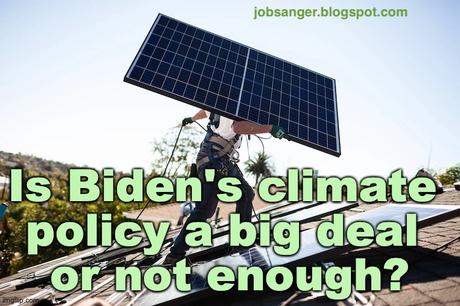
The following is part of an op-ed by Paul Krugman on President Biden's climate policy:
Many observers, myself included, have wondered whether Biden’s climate policy is a big enough deal.
The media often uses hyperbolic language about any program that involves spending hundreds of billions of dollars, so Biden’s climate initiative, which the Congressional Budget Office estimates will involve roughly $400 billion in climate spending, gets described as “massive.” But that’s spending over the course of a decade. And the budget office expects cumulative gross domestic product over the next decade to be more than $300 trillion
So we’re talking about spending only a bit more than one-tenth of 1 percent of G.D.P. Can this possibly be enough to make a real difference in facing an existential threat?
Well, there are two important reasons to believe that Biden’s climate policy may be a much bigger deal than the numbers might suggest. But there are also reasons to worry that the policy may fall short, not because the spending is inadequate, but because of one crucial limiting factor: an inadequate power grid.
The first reason to believe that Biden’s policy may be a big deal is that it comes at a crucial technological juncture.
There was a time, not that long ago, when it seemed as if limiting greenhouse gas emissions would require hard choices — that it would have to be achieved largely through conservation and increased energy efficiency, which in turn would require putting a substantial price on carbon, either via carbon taxes or via a cap-and-trade system in which emitters would have to purchase permits. In fact, there would still be a good case for a carbon tax, if it were politically feasible.
But huge progress in renewable energy and related technologies, notably batteries, means that it now looks almost easy to achieve a low-emission economy. We can now easily envision a society in which people drive electric vehicles and cook on induction ranges, using power generated by solar panels and wind turbines, and experience no sense of sacrifice.
The role of policy then becomes to accelerate this transition — to push us over the tipping point into a sustainable economy. And this need not involve huge amounts of public money, just enough to act as a sort of catalyst for change.
A second, somewhat related reason to think that Biden’s climate policy is a big deal is that it doesn’t actually mandate $400 billion in spending. What it does, mainly, is set conditions under which consumers and businesses can receive tax credits for adopting green technology. That $400 billion is based on an estimate of how many people will actually take advantage of these tax credits — and given the spectacular rate of technological progress, that estimate may well turn out to be low.
A report from Credit Suisse suggests that the credits might “propel much higher activity levels” than the budget office projects — that in practice federal climate spending might be $800 billion or more. And there may also be a multiplier effect as private firms make investments complementary to those directly subsidized, so Credit Suisse suggests that the true size of the climate plan may be more like $1.7 trillion.
So Biden’s deal may be bigger than it looks. Which is a good thing, given the importance of the issue.
Now for my concern. America finally has a serious climate strategy. However, it depends not just on a rapid expansion of solar and wind power, but also on linking these new energy sources to the electrical grid. But the U.S. power grid doesn’t have enough capacity, and it is in general a mess
Part of the reason is that there isn’t really a U.S. grid: Investment in electricity transmission is, as a Reuters report put it, “controlled by a Byzantine web of local, state and regional regulators who have strong political incentives to hold down spending.” And this regulatory system wasn’t designed to handle the sudden influx of new energy sources; as a result, simply getting permission to connect to the grid can take years.
Here’s how I think of it: A clean-energy future suddenly looks eminently possible thanks to a technological miracle — incredible cost declines for renewable energy — and a political miracle — Democrats’ success, despite the narrowest of congressional majorities, in enacting legislation that looks even better when examined closely.
But we may need a third, bureaucratic miracle to fix the electricity grid and make this whole thing work.

